Flowering Cherry Collection
Cherry Cultivar Descriptions & Locations
Here are 26 of the species and cultivars represented in Brooklyn Botanic Garden’s Flowering Cherry Collection. Select “About” to learn more about each cultivar’s blossom characteristics and where to find specimens at BBG.
Visit bbg.org/cherries to track this year’s bloom!
Prunus ‘Accolade’


 Prebloom
Prebloom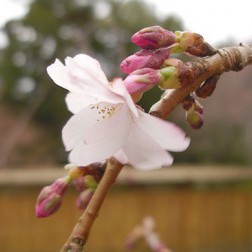
 First Bloom
First Bloom
 Peak Bloom
Peak Bloom
 Post-Peak Bloom
Post-Peak BloomPrunus ‘Accolade’ is an English hybrid between P. subhirtella and P. sargentii. It was first released in 1952 by Knap Hill Nurseries. This tree bears clusters of semidouble, 12-petaled pale pink flowers that open from dark pink buds in early spring.
Location at BBG
Cherry Cultivars Area
Prunus ‘Snow Goose’

 Prebloom
Prebloom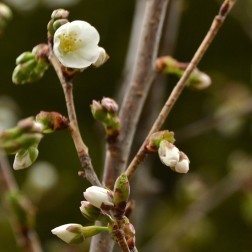
 First Bloom
First Bloom
 Peak Bloom
Peak Bloom
 Post-Peak Bloom
Post-Peak BloomOne of the newest additions to Brooklyn Botanic Garden's collection, ‘Snow Goose’ is an early flowering, very fragrant cultivar with a distinctive upright, flat-topped form. White cup-like blossoms are borne singly or in pairs.
Location at BBG
Japanese Hill-and-Pond Garden (East)
Prunus ‘Hatazakura’

 Prebloom
Prebloom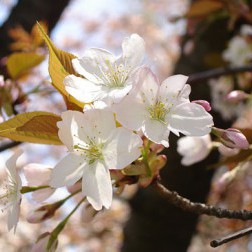
 First Bloom
First Bloom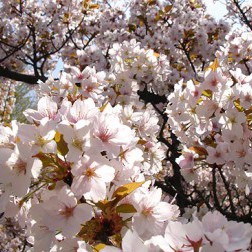
 Peak Bloom
Peak Bloom
 Post-Peak Bloom
Post-Peak BloomHatazakura means “flag cherry.” This medium-size tree produces a profusion of five-petaled pale pink blossoms that turn white when fully open. The tree originated from a celebrated cherry still grown at the Hakusan Shrine in Tokyo.
Location at BBG
Cherry Cultivars Area
Prunus ‘Ojochin’

 Prebloom
Prebloom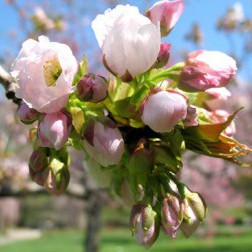
 First Bloom
First Bloom
 Peak Bloom
Peak Bloom
 Post-Peak Bloom
Post-Peak BloomThe flowers are single, large—up to two inches across—and flat; pink buds open to faintly pink to white blossoms borne in pendent clusters. Ojochin means “large lantern.” This tree—one of the larger flowering cherries—has a wide-spreading habit.
Location at BBG
Cherry Cultivars Area
Prunus ‘Shogetsu’

 Prebloom
Prebloom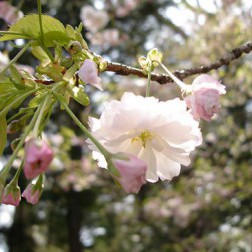
 First Bloom
First Bloom
 Peak Bloom
Peak Bloom
 Post-Peak Bloom
Post-Peak BloomThree to six flowers hang in pendulous clusters on this medium-size cultivar. Shell-pink buds open to semidouble white or faintly pink flowers. Shogetsu means “moon hanging low by a pine tree.”
Location at BBG
Japanese Hill-and-Pond Garden (South of Pond), Osborne Garden
Prunus ‘Spire’

 Prebloom
Prebloom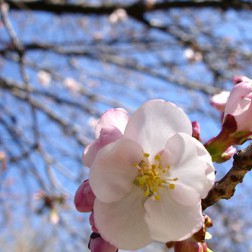
 First Bloom
First Bloom
 Peak Bloom
Peak Bloom
 Post-Peak Bloom
Post-Peak BloomAs its name suggests, this cherry has an upright, narrow conical shape. It is excellent for small gardens and for use as a street tree. Medium-size single flowers create a soft pink cloud in spring; the autumn foliage is also attractive. The cultivar 'Spire' was introduced in 1956 from a cross between P. incisa and P. sargentii
Location at BBG
Cherry Cultivars Area
Prunus ‘Taoyame’


 Prebloom
Prebloom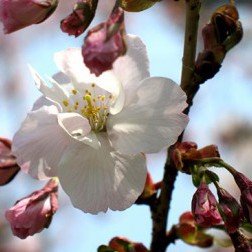
 First Bloom
First Bloom
 Peak Bloom
Peak Bloom
 Post-Peak Bloom
Post-Peak BloomScions of this variety were sent from Japan in 1929 from a tree near the Hirano Shrine in Kyoto. Soft-pink semidouble flowers contrast with a deeper pink on the backs and edges of the petals. Early leaves of a rich purplish-brown tone act as a foil to unfolding blossoms. Taoyame translates as “attractive woman.”
Location at BBG
Cherry Cultivars Area, Japanese Hill-and-Pond Garden (East)
Prunus ‘Ukon’

 Prebloom
Prebloom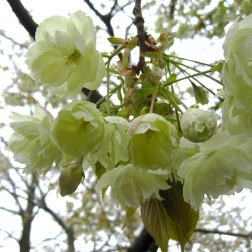
 First Bloom
First Bloom
 Peak Bloom
Peak Bloom
 Post-Peak Bloom
Post-Peak BloomThis cultivar produces an abundance of large, semidouble flowers of a yellowish or pale green color (ukon, for “turmeric,” refers to its unusual color). A hint of pink on the petals adds to the drama of this attractive cherry. Like many of the Prunus serrulata cultivars, ‘Ukon’ was introduced to Western gardeners in the early 20th century.
Location at BBG
Japanese Hill-and-Pond Garden, Osborne Garden
Prunus × dawyckensis

 Prebloom
Prebloom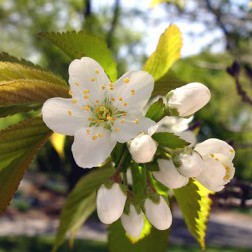
 First Bloom
First Bloom
 Peak Bloom
Peak Bloom
 Post-Peak Bloom
Post-Peak BloomThought to be a natural hybrid raised from a seed sent from China by E.H. Wilson in 1907, this tree’s dark brown bark and fleshy amber-red fruits are its chief characteristics. Single flowers, borne in clusters of three or four, are pale pink to white.
Location at BBG
Cherry Cultivars Area
Prunus × sieboldii

 Prebloom
Prebloom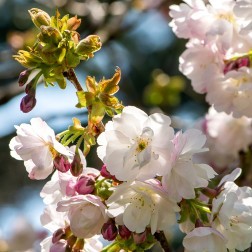
 First Bloom
First Bloom
 Peak Bloom
Peak Bloom
 Post-Peak Bloom
Post-Peak BloomThis tree, among the smaller flowering cherries, produces dark pink buds that open to solid pink blossoms.
Location at BBG
Japanese Hill-and-Pond Garden
Prunus × yedoensis


 Prebloom
Prebloom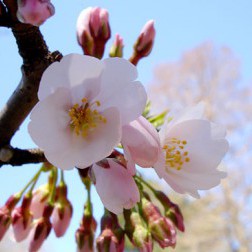
 First Bloom
First Bloom
 Peak Bloom
Peak Bloom
 Post-Peak Bloom
Post-Peak BloomThe single pink blossoms become white with age on Yoshino cherries—considered to be the most widely cultivated cherry in Japan, particularly around Tokyo. The flowers are faintly fragrant. In 1912, the mayor of Tokyo presented the United States with 800 Yoshino cherries, the basis for the famous Tidal Basin display in Washington, DC.
Location at BBG
Japanese Hill-and-Pond Garden (East)
Prunus × yedoensis ‘Akebono’


 Prebloom
Prebloom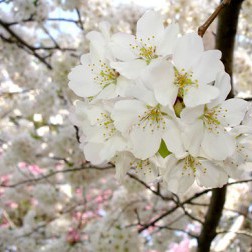
 First Bloom
First Bloom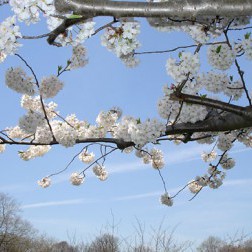
 Peak Bloom
Peak Bloom
 Post-Peak Bloom
Post-Peak BloomThis medium-size tree produces very attractive light pink semidouble flowers that appear before its dark green leaves emerge. Akebono translates as “dawn” or “daybreak.”
Location at BBG
Cherry Cultivars Area, Parking Lot Hill
Prunus ‘Ariake’

 Prebloom
Prebloom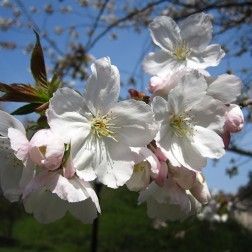
 First Bloom
First Bloom
 Peak Bloom
Peak Bloom
 Post-Peak Bloom
Post-Peak BloomThis cultivar is thought to have been first introduced to the United States in 1912 as part of Washington DC’s Potomac Park flowering cherry collection. Its single large flowers are white to pale pink; mature trees may produce an additional petal in flower centers.
Location at BBG
Japanese Hill-and-Pond Garden, Overlook Slope
Prunus ‘Fudan-zakura’


 Prebloom
Prebloom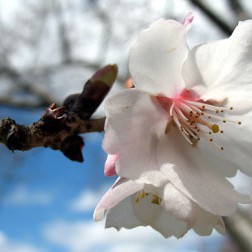
 First Bloom
First Bloom
 Peak Bloom
Peak Bloom
 Post-Peak Bloom
Post-Peak BloomFudan zakura means “continuous cherry.” Known to bloom for long periods in Japan, this rather small tree flowers off and on throughout mild winters. The flower buds are pale pink, opening to white flowers.
Location at BBG
Cherry Cultivars Area, Japanese Hill-and-Pond Garden, Parking Lot Hill
Prunus ‘Kanzan’


 Prebloom
Prebloom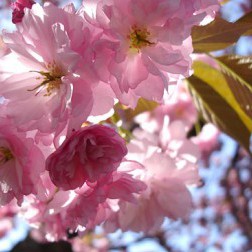
 First Bloom
First Bloom
 Peak Bloom
Peak Bloom
 Post-Peak Bloom
Post-Peak BloomThis popular cultivar is considered by many to be the most showy ornamental cherry. Flowering is extravagant, with pink, almost magenta double blossoms borne in hanging clusters. The double blossoms of this cultivar were bred to have up to 28 petals each. (Cherry blossoms naturally have five petals.) Cherry Walk and Cherry Esplanade provide an opulent annual display of ‘Kanzan’.
Location at BBG
Cherry Esplanade, Cherry Walk
Prunus ‘Kurama-yama’

 Prebloom
Prebloom
 First Bloom
First Bloom
 Peak Bloom
Peak Bloom
 Post-Peak Bloom
Post-Peak BloomThe flowers of this double-flowered cherry are pink with pale centers and hang in clusters of three or four. The buds are a slightly deeper pink.
Location at BBG
Cherry Cultivars Area
Prunus ‘Shirotae’

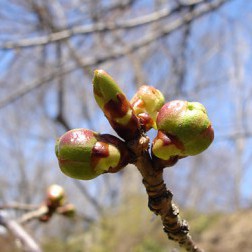
 Prebloom
Prebloom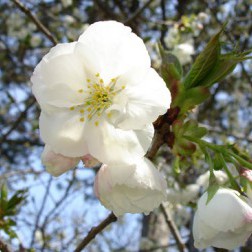
 First Bloom
First Bloom
 Peak Bloom
Peak Bloom
 Post-Peak Bloom
Post-Peak BloomThe name of this double-flowered cherry means “snow white”; it is sometimes also referred to as ‘Mount Fuji’. The tree’s pink-tinted buds open to clusters of dazzling white, fragrant flowers. These wide-spreading trees grow to 25 feet tall.
Location at BBG
Japanese Hill-and-Pond Garden, Osborne Garden (East), Overlook Slope
Prunus ‘Taki-nioi’

 Prebloom
Prebloom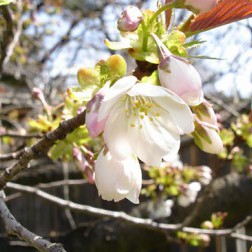
 First Bloom
First Bloom
 Peak Bloom
Peak Bloom
 Post-Peak Bloom
Post-Peak Bloom
The name for this small cherry, meaning “fragrant cloud” or "fragrance of a waterfall," addresses its main feature—its scent—which is rather honeylike. Copious single white blossoms are small but dramatically highlighted by reddish-bronze foliage.
Location at BBG
Cherry Cultivars Area
Prunus × incam ‘Okame’


 Prebloom
Prebloom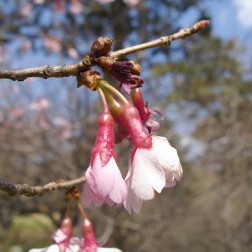
 First Bloom
First Bloom
 Peak Bloom
Peak Bloom
 Post-Peak Bloom
Post-Peak BloomThis hybrid of the Formosan and Fuji cherries was introduced to Europe in 1947 by Collingwood Ingram, a renowned authority on Japanese flowering cherries. Its deep carmine-rose buds open to lighter-tinted flowers before leaves appear. This small- to medium-size tree is excellent for small gardens and is also showy in fall, with orange-red leaves. This variety is recommended by the Garden Club of America's book, Plants That Merit Attention.
Location at BBG
Cherry Cultivars Area, South of Rose Family Bed
Prunus × subhirtella

 Prebloom
Prebloom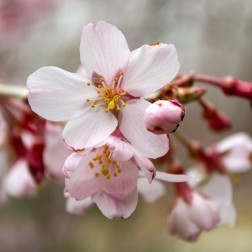
 First Bloom
First Bloom
 Peak Bloom
Peak Bloom
 Post-Peak Bloom
Post-Peak BloomThis tree is also called a higan cherry and produces delicate pink blossoms on branches that take a wide-spreading, vase-shaped form.
Location at BBG
Japanese Hill-and-Pond Garden
Prunus × subhirtella ‘Jugatsu-zakura’

 Prebloom
Prebloom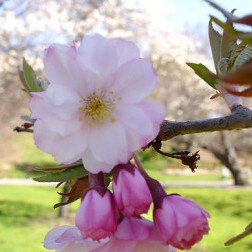
 First Bloom
First Bloom
 Peak Bloom
Peak Bloom
 Post-Peak Bloom
Post-Peak BloomFormerly known as, ‘Autumnalis’, ‘Jugatsu-zakura’ begins blooming around October, continues sporadically into December, and finishes in the spring with a last burst coinciding with new foliage. Pale pink flowers are single to double and can be quite striking during winter thaws.
Location at BBG
Cherry Cultivars Area, Washington Avenue Display
Prunus × subhirtella ‘Rosy Cloud’


 Prebloom
Prebloom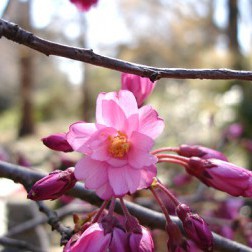
 First Bloom
First Bloom
 Peak Bloom
Peak Bloom
 Post-Peak Bloom
Post-Peak BloomThis lovely cultivar produces soft-pink double flowers and attractive autumn foliage. It grows to 20 to 25 feet with an upright spreading habit.
Location at BBG
Cherry Cultivars Area
Prunus hirtipes


 Prebloom
Prebloom
 First Bloom
First Bloom
 Peak Bloom
Peak Bloom
 Post-Peak Bloom
Post-Peak BloomThe introduction of this early-blooming cherry to the Western Hemisphere is attributed to plant explorer E.H. Wilson, who made numerous sojourns to the hills of western China in the early 1900s. Following on the heels of the snowdrops, this elegant cherry (formerly known as Prunus conradinae) produces slightly fragrant single flowers, white with a pale pink cast, in early April or occasionally late March.
Location at BBG
Plant Family Collection
Prunus pendula ‘Yae-beni-shidare’

 Prebloom
Prebloom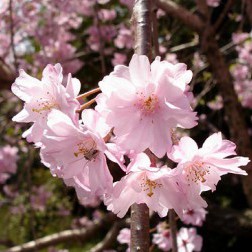
 First Bloom
First Bloom
 Peak Bloom
Peak Bloom
 Post-Peak Bloom
Post-Peak BloomThis weeping cherry is also called the Sendai spring cherry. It has red buds that open to double pink flowers on broadly weeping branches.
Location at BBG
Cherry Esplanade, Japanese Hill-and-Pond Garden
Prunus pendula ‘Pendula Rosea’


 Prebloom
Prebloom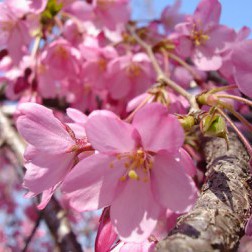
 First Bloom
First Bloom
 Peak Bloom
Peak Bloom
 Post-Peak Bloom
Post-Peak BloomSeeds of this variety, often called weeping higan cherry, were first brought from Japan around 1862 by plant hunter Philipp Franz von Siebold. They produce delicate blossoms in colors ranging from nearly white to pale pink.
Location at BBG
Cherry Cultivars Area, Cherry Esplanade, Japanese Hill-and-Pond Garden
Prunus serrulata ‘Horinji’

 Prebloom
Prebloom
 First Bloom
First Bloom
 Peak Bloom
Peak Bloom
 Post-Peak Bloom
Post-Peak BloomThis cultivar's dark pink buds open to semidouble flowers with soft white or pale pink petals set against rich pinkish-purple outer petals. This profusely flowering small tree is named for an ancient Buddhist temple in Kyoto.
Location at BBG
Cherry Cultivars Area, Japanese Hill-and-Pond Garden (South of Pond)


